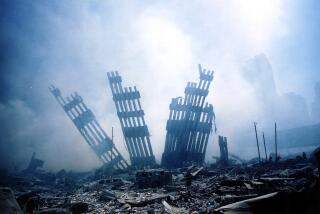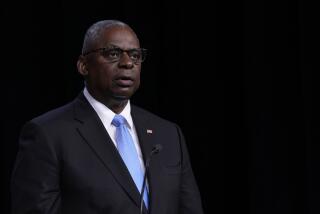A Plan to Avenge Cole Blast Must Consider Risks
WASHINGTON — With U.S. officials increasingly confident that they will soon determine who bombed the warship Cole, policymakers and national security officials here are beginning to consider how best to meet President Clinton’s vow to hold the perpetrators “accountable.”
Officials said they have not ruled out any option, from a missile strike against those who orchestrated the attack to a covert military operation to snatch suspects and bring them to trial.
But the White House, which was stung by claims that it relied on faulty intelligence when it fired cruise missiles at an alleged chemical weapons plant in Sudan after the 1998 bombing of two U.S. embassies in East Africa, has raised the bar for a major military response this time.
“People are saying let’s make sure before we present any options of striking back that the standard of evidence is a lot higher than last time,” said a Clinton administration official who is familiar with the initial discussions and who requested anonymity.
A massive display of military force also could backfire against long-term U.S. interests by exacerbating the tension and bloodshed now roiling the Middle East. Over the last month, more than 120 people have died in rioting in Israel and Palestinian-controlled areas, heightening anxiety throughout the Arab world.
“It’s different from any time in the past because the situation in the Mideast is so incredibly volatile,” warned Bruce Hoffman, a terrorism expert at the Washington office of the think tank Rand Corp.
The timing of any retaliation is also a delicate issue. Though officials insist that the U.S. presidential election is not a factor in their planning, its occurrence in two weeks complicates matters. It is not clear, however, whether an attack would benefit or hurt Vice President Al Gore’s chances at the ballot box, and Texas Gov. George W. Bush has been careful to back the administration on recent foreign policy calls.
White House officials insist that it is still too early to make a decision or even a recommendation, since there is no conclusive evidence or intelligence on exactly who provided the training, expertise, financing and plans for the Oct. 12 suicide bombing of one of America’s newest and most advanced warships.
They also have sharply restricted information about the case, both to protect the investigation and to avoid tipping off potential targets of U.S. retaliation.
White House spokesman Jake Siewert declined to discuss the investigation Tuesday. But he said, “Obviously the president is looking to his team to do the best job that they can in tracking down the people responsible for that bombing.”
Pressure for a response has mounted since the weekend, when U.S. intelligence agencies received what officials called credible threats of terrorist attacks on U.S. troops and diplomats in Turkey and the small Persian Gulf states of Qatar and Bahrain.
‘Multiple Threats’ Have Been Received
About 1,100 U.S. troops in Bahrain and 50 in Qatar were put on the highest military alert status, known as Defcon Delta, following “multiple . . . specific threats” of attack by extremist groups, defense officials said Tuesday.
Bahrain is home port for the U.S. 5th Fleet, while U.S. troops in Qatar manage Army equipment that is stored there in case war breaks out in the region. U.S. forces in Turkey were put on Defcon Charlie, the second-highest alert status.
Defense officials declined to provide details of the threats. But a U.S. intelligence official said they appear linked to the bombing of the Cole, which killed 17 U.S. sailors and wounded 39 shortly after the guided missile destroyer steamed into the harbor at Aden, Yemen.
The White House cited similar terrorist threats made against U.S. forces abroad when it launched 79 cruise missiles against targets linked to Osama bin Laden in Afghanistan and Sudan on Aug. 20, 1998. That was 13 days after huge truck bombs devastated U.S. embassies in Kenya and Tanzania and killed more than 220 people.
At the time, U.S. officials insisted that the missile strikes were aimed at preempting further terrorist attacks by Bin Laden and his allies. The White House said it had evidence, which was never publicly disclosed, that the wealthy Saudi militant was planning imminent attacks on Americans around the world.
In June 1993, a barrage of 23 U.S. cruise missiles hit and heavily damaged Iraq’s intelligence complex in Baghdad in retaliation for what Clinton called a “particularly loathsome and cowardly” Iraqi plot to assassinate former President Bush during a visit to Kuwait several months before.
This time, the administration is under pressure to ensure that the quality of intelligence and standard of evidence are sufficient to avoid the criticism that arose after the 1998 U.S. missile strikes on the Shifa Pharmaceutical plant in Khartoum, Sudan.
White House officials insisted then--and continue to argue today--that the attack was justified because a soil sample indicated that the factory had produced a key ingredient for VX, a deadly nerve gas. Defense Secretary William S. Cohen later conceded that the plant also manufactured medicine.
“The idea we have to do something is important,” said Gregory Treverton, former vice chairman of the National Intelligence Council. “But if we look feckless, or look nasty by killing a bunch of innocent people, then we hurt our case.”
The FBI Looks for a Terrorist ‘Signature’
By all accounts, U.S. and Yemeni investigators have made substantial progress in the Cole probe. They have raided at least five “safe houses” that reportedly were used by the bomb makers and accomplices in Aden; recovered false identification papers; and seized a Nissan four-wheel-drive vehicle and a haul of other evidence.
FBI lab technicians in Washington are analyzing bomb fragments and other evidence collected from the crippled warship in an effort to determine if the design of the bomb and its detonator matches the “signature” of known terrorists, and whether the device contained commercial or military explosives that can be traced.
If evidence again points to Bin Laden, another missile attack on “mud huts in Afghanistan might make us feel good but wouldn’t do much good,” warned Kenneth Katzman, a terrorism expert at the Congressional Research Service.
Jonathan Pollack, chairman of the strategic research department at the Naval War College in Newport, R. I., said the optimum response would be the capture of the chief plotters, wherever they are. “Bringing someone to justice would have enormous appeal,” he said.
But chances “are very low” that elite U.S. troops could snatch Bin Laden from his Afghan redoubt, said Michael S. Swetnam, president of the Potomac Institute for Policy Studies, a nonprofit think tank in Washington.
“Bin Laden knows he’s a target,” Swetnam said. “So he hides, and he puts out Bin Laden look-alikes across Afghanistan and the Middle East.”
Hoffman of Rand Corp. also warned against overreacting, even if the evidence clearly indicates that Bin Laden had a hand in the Cole attack. The 1998 U.S. missiles may have disrupted Bin Laden’s plans, but they also boosted his image as a super-terrorist standing up to a superpower.
“We’ve turned him into a David versus Goliath,” Hoffman said. “You had kids named Osama from North Africa to Pakistan. . . . We’re a superpower, and this one guy forces us to close dozens of embassies. He doesn’t even have to do anything and he makes us jump.”
*
Times staff writer Paul Richter contributed to this report.
(BEGIN TEXT OF INFOBOX / INFOGRAPHIC)
U.S. Troops in the Mideast
Recent tension in the Mideast has put many U.S. troops in the region on heightened alert. Here is the number of active-duty American military personnel by country:
*
TURKEY: 2,105
KUWAIT: 5,469
U.A.E: 346
OMAN: 277
QATAR: 46
SAUDI ARABIA: 5,397
EGYPT: 205
BAHRAIN: 1,112
*
Source: Department of Defense
Note: Numbers as of June 30
More to Read
Sign up for Essential California
The most important California stories and recommendations in your inbox every morning.
You may occasionally receive promotional content from the Los Angeles Times.











